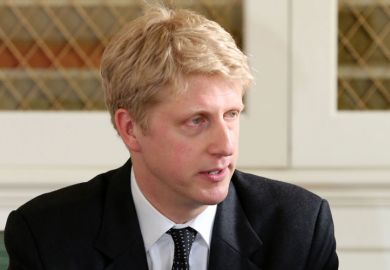Few institutions have the longevity and deep roots of universities.
Yet even those that have been around long enough to survive plagues, fires and revolutions are finding that the combination of Brexit and the coronavirus is stretching their resilience and endurance to the limit.
As international students scramble home to continue classes online, governments in the English-speaking countries dominant in the global education industry are waking up to the existential threat their disappearance poses to universities young and old.
Over the last decade, the number of international students worldwide has almost doubled to 5 million. Before the coronavirus struck, this trend was set to continue unabated, with predictions of over 10 million overseas students by 2030.
No one today has visibility or confidence in forecasts over that sort of timeframe.
Post-crisis, the market for international students will be even more competitive. It is likely that there will be increased reluctance to travel overseas, even when travel restrictions are lifted, and that there will be a smaller pool of students with the means to do so.
A number of published surveys suggest a substantial decline in international numbers, as well as significant rates of deferrals by domestic students. These need to be read with caution. What people say they will do and what they actually do aren’t always the same.
What is a near certainty, however, is that international students are unlikely to return to physical campuses in North America, the UK and Australia in anything like the same numbers for the start of the new academic year this September.
Governments and university leaders are preparing for a potential drop in international students of 50 to 75 per cent that would represent a significant reversal for one of the great boom businesses of the globalised economy.
Any decline of this magnitude would expose real vulnerabilities in university finances and highlight the way universities have been the victim of competing and conflicting government policy objectives in Westminster over much of the last decade.
Governments have long required universities to develop additional revenue streams to cross-subsidise research, which loses 25p on the pound, and the teaching of certain strategically significant laboratory and studio-based subjects that cost more to deliver than the £9,250 fees paid by domestic students.
They have recognised that, far from squeezing out qualified domestic students, overseas students have made viable courses and research opportunities that would otherwise not be offered.
International students have not only contributed to a diverse learning environment that benefits all students, but supported economic activity in university towns from Chichester to Aberdeen and expanded the UK’s cultural, diplomatic and trade relationships around the world.
For much of the last decade, however, the UK government has run contradictory policies aimed both at increasing education exports, while at the same time managing down international student numbers in a misguided attempt to reduce overall net migration to below 100,000.
This confusion and ambivalence has created a volatile and unstable policy environment that helps explain why the UK – a perennial world leader in education – has gradually seen its share of the international education market slip over the past 10 years.
For many years, the top three destinations for international students have been the United States, the United Kingdom and Australia. But recently global student mobility has begun to shift.
The UK’s market share declined in 17 out of the world’s 21 top sending countries between 2010 and 2017. And UK international student numbers have in recent years been flat rising by just 0.3 per cent in 2016 and only 0.9 per cent in 2017.
By contrast, Australia has now seen steady year-on-year growth of around 14 per cent and might soon catch up with the UK in terms of total overseas numbers, if it has not done so already.
Thanks in part to the hostility to international students from “Agent May”, as Canadian bloggers knew the UK prime minister, Canada has also increased its market share in several top sending countries.
Meanwhile, China, long the biggest source of students, is now on the verge of becoming a global superpower in higher education in its own right, deploying the full weight of its government and economy in support of its own soft power objectives.
How rapidly UK universities bounce back post-Covid-19 will be of central importance to the UK’s economic recovery and, in the wake of the pandemic and in anticipation of the end of the Brexit transition period, the government is now sensibly revising its international education strategy.
This is a key element in the “Global Britain” vision for the country. It is vital it is suitably ambitious. The previous strategy, published in March 2019, set UK universities the target of attracting 600,000 international students by 2030 (an increase of around 25 per cent on current numbers).
While presenting themselves as bold, the targets, as my recently published paper shows, were nothing of the sort. By settling for growth rates significantly slower than the global market for international students had enjoyed over the previous decade (double in the past 10 years), the targets tacitly accepted a steady loss in the UK market share.
The objectives set by the UK government for the sector in May 2019 put us on a trajectory that would see our market share halve by 2030 and see the UK fall down the global rankings of destination countries. If the UK is to protect one of the few industries in which it still leads the world, it must take a number of steps to be first out of the blocks.
These include a study visa that matches the best in the world, with four years’ post-study work, the transformation of the British Council into a body focused on promotion of study in the UK, and a strategic push to rebalance student flows by doubling those from India within the lifetime of this Parliament.
Failure by a Conservative government to act to shore up our position in the market for international students would also represent a weakening of an important part of Margaret Thatcher’s legacy.
One of her early and most controversial decisions was to remove the public subsidy for overseas students, to abolish number controls applying to them and to leave overseas student recruitment entirely to the market.
That bold reform then took us, over the next 30 years, to 400,000 overseas students and a market share second only to the US. We long ago passed the point where the income our universities earn from overseas students exceeded total government grants to them for teaching domestic students.
If we really care about our post-Brexit future as a trading nation, about deregulation and unleashing enterprise, we would be cutting back the time-consuming and off-putting red tape affecting overseas students and instead go full throttle to achieve even more ambitious education export objectives.
By taking the simple measures outlined in my paper, the government can help universities compete more effectively in the global market for international education and play their full part in putting the bounce back in Global Britain.
Jo Johnson is a former UK minister of state for universities, science, research and innovation
This is an edited version of the foreword to Mr. Johnson's report “Universities open to the world: How to put the bounce back in Global Britain”
Register to continue
Why register?
- Registration is free and only takes a moment
- Once registered, you can read 3 articles a month
- Sign up for our newsletter
Subscribe
Or subscribe for unlimited access to:
- Unlimited access to news, views, insights & reviews
- Digital editions
- Digital access to THE’s university and college rankings analysis
Already registered or a current subscriber? Login








